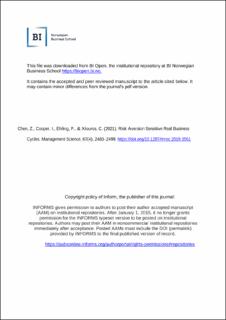Risk Aversion Sensitive Real Business Cycles
| dc.contributor.author | Zhanhui, Chen | |
| dc.contributor.author | Cooper, Ilan | |
| dc.contributor.author | Ehling, Paul | |
| dc.contributor.author | Xiouros, Costas | |
| dc.date.accessioned | 2023-05-12T16:44:24Z | |
| dc.date.available | 2023-05-12T16:44:24Z | |
| dc.date.created | 2021-02-23T20:28:38Z | |
| dc.date.issued | 2020 | |
| dc.identifier.citation | Management science. 2020, . | en_US |
| dc.identifier.issn | 0025-1909 | |
| dc.identifier.uri | https://hdl.handle.net/11250/3067836 | |
| dc.description.abstract | Technology choice allows for substitution of production across states of nature and depends on state-dependent risk aversion. In equilibrium, endogenous technology choice can counter a persistent negative productivity shock with an increase in investment. An increase in risk aversion intensifies transformation across states, which directly leads to higher investment volatility. In our model and the data, the conditional volatility of investment correlates negatively with the price-dividend ratio and predicts excess stock market returns. In addition, the same mechanism generates predictability of consumption growth and produces fluctuations in the risk-free rate | en_US |
| dc.language.iso | eng | en_US |
| dc.publisher | Informs | en_US |
| dc.title | Risk Aversion Sensitive Real Business Cycles | en_US |
| dc.type | Journal article | en_US |
| dc.type | Peer reviewed | en_US |
| dc.description.version | acceptedVersion | en_US |
| dc.source.pagenumber | 2483-2499 | en_US |
| dc.source.volume | 67 | en_US |
| dc.source.journal | Management science | en_US |
| dc.source.issue | 4 | en_US |
| dc.identifier.doi | 10.1287/mnsc.2019.3561 | |
| dc.identifier.cristin | 1892946 | |
| cristin.ispublished | true | |
| cristin.fulltext | postprint | |
| cristin.qualitycode | 2 |
